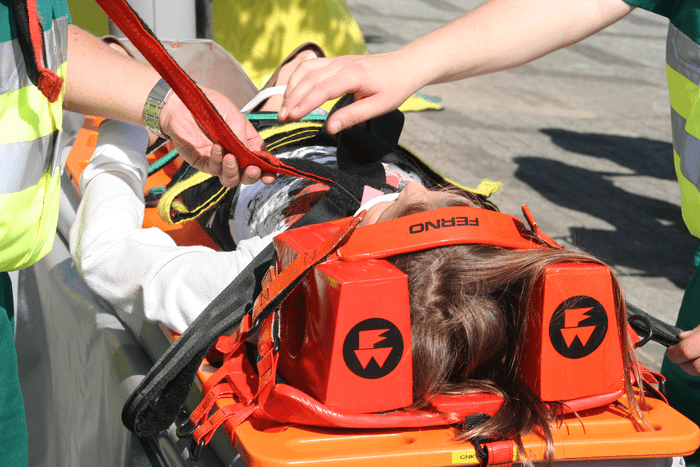
Responding to pediatric medical emergencies is never easy, especially since most such emergencies involve some form of trauma. Emergencies involving traumatic injuries to a child can be highly stressful events not only for the patient and their family, but for you, the responder, as well. Motor vehicle accidents, falls, and bicycle crashes are just a few of the scenarios that can result in serious, even life-threatening injuries for children; between infancy and adulthood, traumatic injuries make up the most common cause of death, according to the American Academy of Pediatrics (AAP).1
Treating pediatric trauma requires a targeted approach. Children are not simply small adults; you must tailor your assessment and your treatment strategy to accommodate not only their smaller size, but their developing bodies, which include differences in skeletal growth, metabolism, and the way they respond to injury and illness.
The most essential part of your treatment strategy involves airway management—primarily maintaining airway patency. One of the most useful tools for airway management is your portable suction unit. We want to offer up some suction advice for treating pediatric trauma patients.
A Tailored Approach to Treating Children
Depending on your level of experience with and exposure to children, your initial impression when treating pediatric trauma victims will range from calm confidence to contained panic. If you’re a parent, you are more attuned to the behavior and reactions of injured children. For those who have spent little time around young ones, though, the patient’s response to trauma may come across as confounding. Not only is the pediatric patient dealing with the pain of injury, but they must also handle the stress of the situation, not to mention their fear of strangers (you!). That’s a lot for a child to deal with.
Use a calm, comforting approach when treating pediatric patients. This will reduce their anxiety and forge trust. Don’t lie to the child. If a treatment is going to hurt (for example, IV insertion, splinting, or fracture reduction in a limb lacking distal pulses), be honest and reassure the patient that the treatment is necessary and that you will do your very best to reduce their pain.
Don’t talk down to the child—literally! Standing above the patient will only intimidate them further. Squat or kneel before the child so you can communicate at eye level. Make eye contact as you reassure the patient, and don’t forget the importance of touch. A gentle hand can help soothe a frightened child and reinforce a caring approach.
The Essentials of Assessment and Immediate Intervention
When assessing the pediatric trauma patient, you must recognize the need for immediate interventions during your initial assessment. The AAP details the elements of a pediatric trauma assessment in their Pediatric Education for Prehospital Professionals (PEPP) guidelines. Special interventions associated with the ABCDEs of the pediatric trauma assessment include:
- Airway: modified jaw thrust while maintaining cervical spine immobilization, or consider an airway adjunct
- Breathing: needle thoracostomy or applying dressing to a sucking chest wound
- Circulation: external hemorrhage control or splinting fractured extremities
- Disability: elevated intracranial pressure management by elevating the head of the backboard and assisting ventilation to maintain normal CO2 levels
- Exposure: preventing heat loss
Recognizing the need for immediate interventions requires confidence, rapid decision-making, and an aggressive approach to treatment. As stated above, no intervention is more critical than clearing the airway.
Suctioning the Pediatric Patient
There are several ways a trauma victim’s airway can become obstructed: excessive bleeding from facial or oral trauma; vomitus resulting from abdominal or head injuries; swelling and edema that restricts air movement; even something as simple as the tongue, broken teeth, or tissue getting in the way. Any of these scenarios can result in airway obstruction, and the most efficient means of preventing or clearing an obstructed airway is through effective oral suctioning.
Our advice for suctioning the pediatric trauma victim includes the following important factors:
- ALWAYS have the portable suction unit on hand—include it with your ALS equipment or stow it in the airway/trauma bag.
- Check your suction unit at the start of each shift to ensure it is clean, charged, stocked (with a range of catheters), and functioning.
- Avoid overaggressive suctioning to prevent damaging the child’s fragile oral and nasal tissues.
- Use the appropriate size catheter to accommodate the tight confines of the child’s mouth.
- Prevent hypoxia by restricting suction time to under ten seconds.
- Explain what you are doing if the patient is conscious, as they may be scared of the noise of the machine and the insertion of the catheter.
Pediatric trauma does not have to be scary—for you or your patient. As a responder, you can do a lot to reduce fear and stress for all involved. Just remember that children require a tailored approach that involves good communication, rapid recognition, and confident, assertive treatment, especially when suctioning the airway.
12014
Pediatric Education for Prehospital Professionals, American Academy of Pediatrics, Jones & Bartlett.















